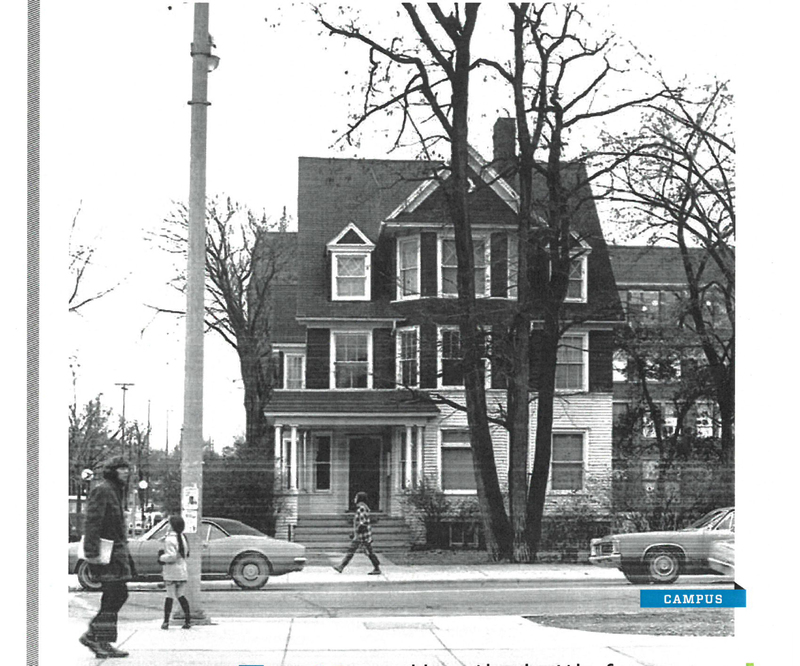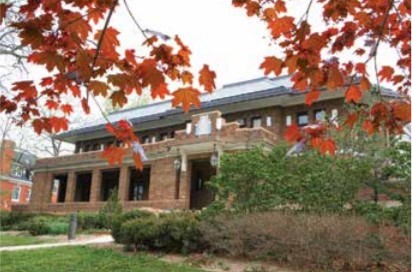Trotter Multicultural Center Background
The Trotter Multicultural Center, as it is known today, began as Trotter House, a Black Student Cultural Center. African American students united under the banner of the Black Action Movement (BAM) to help students who experienced obstacles within their educational process. Trotter House was born out of this movement.
In the image above, Trotter House, a large, shabby, Victorian located at the corner of South and East University Avenues, specifically at 1020 South University Avenue, sits among tall trees and shrubbery. The house was formerly used as a special projects house for the School of Education. The building had been partially remodeled, but several rooms needed painting and carpeting. A group of African American students volunteered to do the painting. This house would be the home of the first iteration of the Trotter House, named in honor of William Monroe Trotter (1872-1934).
William Trotter, wearing a suit and tie in the portrait above, was a businessman, journalist, and activist. He graduated Phi Beta Kappa from Harvard in 1895, the first African American to graduate with that honor. In 1901 he founded the Boston Guardian newspaper, which quickly became one of the most important newspapers of the national Black Press. The first issue of the Guardian appeared on November 9, 1901, and Trotter promised its readers “an organ which is to voice intelligently the needs and aspirations of the colored American.” In addition he wrote, “We have come to protest forever against being proscribed or shut off in any caste from equal rights with other citizens, and shall remain forever on the firing line at any and all times in defence of such rights.” On the Guardian masthead Trotter called the paper “America’s greatest race journal.”
Trotter advocated for a radical Black Liberation long before Malcolm X. Some of his activism included leading national protests against screenings of the film The Birth of a Nation. Along with leaders like W.E.B. Du Bois, Trotter was one of the founders of the Niagara Movement that contributed to the creation of the National Association for the Advancement of Colored People (NAACP). In a widely publicized meeting with President Woodrow Wilson, he protested against the introduction of segregation in the federal workplace.
He died on his birthday, on April 7, 1934. During this period, Trotter was facing a loss of standing among activists, and the Guardian was facing major financial problems. When Trotter was worried or troubled he would go up on the roof of his apartment building and pace back and forth with his eyes closed, talking to himself. While pacing on his 62nd birthday, Trotter — accidentally or deliberately — walked off the roof and fell to his death.
Originally purchased by the University in 1921, Trotter House opened for operation on November 15, 1971. Trotter House immediately took advantage of its 3 stories and 15 rooms, hosting a wide array of programming. At Trotter House, Black students could find lunches, art workshops, new student orientations, academic and career counseling, a chess clinic, and parties and dances, to name just a few.
On May 7, 1972 The Trotter Multicultural Center was destroyed when a defective gas water heater started a fire. A Michigan Daily story, “Black Student Center: Trotter House Gutted by Fire,” by Nancy Rosenbaum, reported that the fire that gutted the first Trotter House was discovered by students after a Sunday dinner. The students smelled smoke and the building was evacuated. Despite rumors of the fire being a retaliatory, racially-motivated arson, a defective water heater was believed to be the cause of the fire. The destruction caused by the fire was partly due to the age of the building and the lack of fire safety measures. The building was estimated to be 65 years old and was constructed without fire stops, making the fire hard to contain.
In June 1972, the university purchased a building to house the center at 1445 Washtenaw Ave, pictured above. The new 11,300 square-foot facility was the former Phi Kappa Sigma fraternity house, built in 1924. The new center was quickly remodeled and up and running. The Trotter Multicultural Center continued to grow, and in 1981 expanded its focus to become a multicultural student center. Today, the Trotter Multicultural Center, a 10-million-dollar facility, works to enhance multicultural awareness across campus and be a place where all University of Michigan students, faculty, staff, and alumni can hold meetings and events.

The Black Action Movements (B.A.M.)



